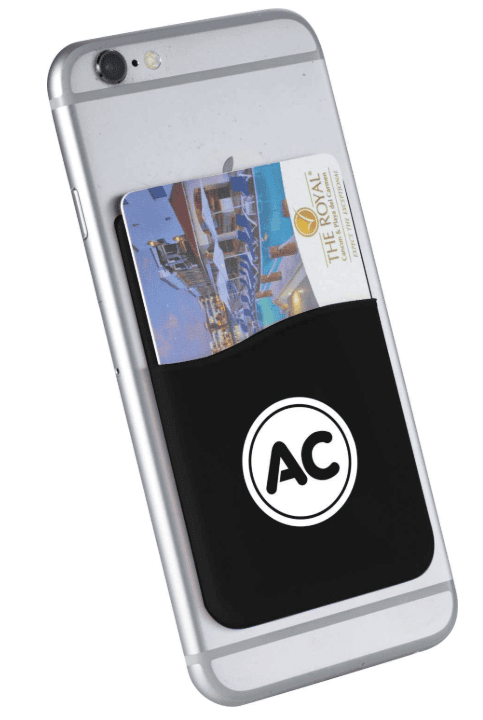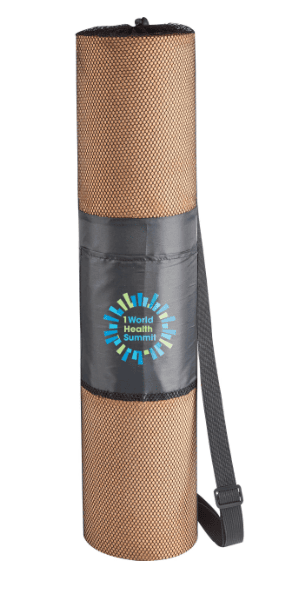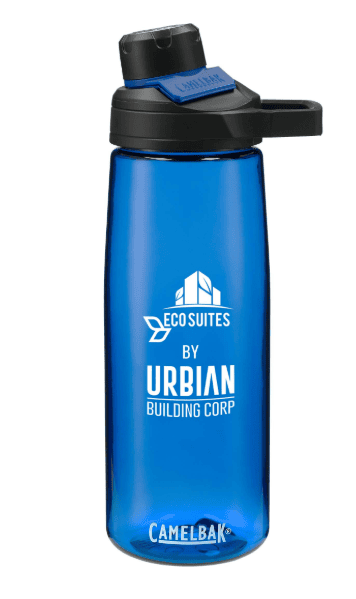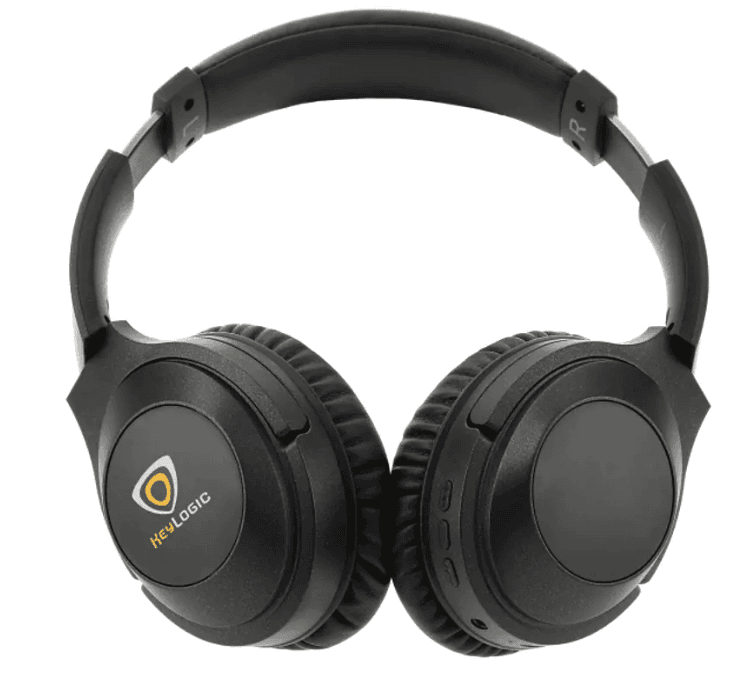Mental Health Awareness Month in May and World Mental Health Day in October offer businesses key opportunities to spotlight mental well-being at work.
Promoting mental health requires consistency, creativity, and genuine care, but the right activities can make a lasting impact.
Everything from starting a digital appreciation channel to bringing in a wellness coach can yield incredible mental health benefits.
Supporting mental well-being matters because it affects multiple aspects of your business, including employee productivity and retention, teamwork, and ROI.
After all, unmanageable workloads, toxic or isolating company cultures, and a lack of recognition can all greatly influence mental health.
Therefore, it’s time to step up your game and take meaningful action.
Discover 20 practical and engaging mental health awareness activities to help employees learn about the four As of mental health.
Let’s get started!

Table of Contents
What Is Mental Health Awareness Month?
When Is World Mental Health Day?
How Do You Promote Mental Health in the Workplace?
20 Mental Health Awareness Activities & Ideas for Employees
Why Is Mental Health Important in the Workplace?
How Does Work Impact Mental Health?
What Are the 4 As of a Mental Health-Friendly Workplace?
Why Do Workplace Mental Health Initiatives Fail (And How Can You Avoid It)?
What Is Mental Health Awareness Month?
Mental Health Awareness Month occurs every May and has been recognized in the United States since 1949.
This initiative began as a way to increase understanding of mental health issues and reduce the stigma that often surrounds them.
Over time, Mental Health Awareness Month has grown into a national movement that encourages open conversations and promotes access to care.
For workplaces, this month provides an excellent opportunity to prioritize employee well-being.
Use this time to educate, support, and connect with your teams in meaningful ways, which will build a healthier, more resilient work culture.
Next, we’ll explain what World Mental Health Day is all about.
When Is World Mental Health Day?
World Mental Health Day falls on October 10 each year and is a global reminder to prioritize mental well-being.
The World Federation for Mental Health launched this awareness day in 1992 to boost education, encourage support, and spark action around mental health issues.
Organizations worldwide use this key business date to highlight the importance of mental health and share solutions that make a real difference.
On World Mental Health Day, you can plan internal events, host discussions, or launch wellness initiatives that show employees their mental health matters.
Let’s see how you can promote mental health in your company.
How Do You Promote Mental Health in the Workplace?
Support employee mental health by creating a workplace culture where care, openness, and support feel natural.
Here are several effective ways to promote mental well-being in your work environment.
Offer mental health days
Encourage employees to take time off to rest and recharge without needing to justify it. These days help prevent burnout and support emotional balance.
Host workshops and training
Bring mental health professionals or provide guided sessions on stress management, mindfulness, or mental wellness. These opportunities build awareness and normalize mental health conversations.
Schedule regular check-ins
Create a safe space for honest dialogue through regular one-on-one check-ins. When leaders actively listen, employees feel valued and heard.
Provide access to Employee Assistance Programs (EAPs) and resources
Give employees direct access to counseling services, hotlines, and other mental health resources. Easy access can make all the difference.
Reward participation with meaningful swag
Rewarding employee participation in mental health programs with non-monetary incentives can increase engagement and boost morale.
SwagDrop’s swag-on-demand shops offer a seamless solution that simplifies this process.
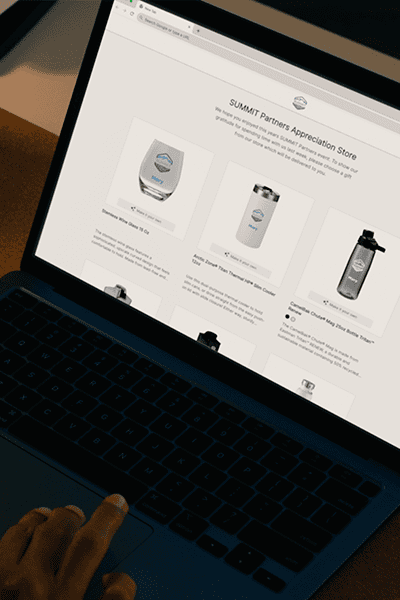
Here’s how it works.
- You browse our extensive product catalog and curate promotional products that align with your brand, team members, or mental health initiatives.
- We create a virtual employee gift shop for your company, with zero setup or inventory costs.
- Employees choose their preferred reward from high-quality company swag items, including self-care gift sets, apparel, drinkware, tech gadgets, and cool office supplies.
- Once we receive all the orders, we print, pack, and dropship each corporate gift to the recipient’s doorstep for only $9.95.
This strategy can make staff members feel valued and appreciated, building a workplace culture of recognition that supports corporate wellness.
Next, we’ll explore 20 practical mental health awareness activities your team will enjoy.
20 Mental Health Awareness Activities & Ideas for Employees
We’ve gathered insights from our clients and researched workplace wellness trends to create this list of practical, easy-to-execute ideas.
These activities promote mental well-being while also creating opportunities for meaningful employee engagement.
1. Start a “Blanket & Breathe” mindfulness break using Sherpa blankets
Create short midday sessions where employees take 15 minutes to step away from their screens, breathe deeply, and ground themselves while wrapped in a cozy Sherpa custom blanket.
The polyester fleece’s incredibly soft texture and warmth help relax the body while deep breathing exercises calm the mind.
These breaks build a culture of mindfulness and show employees that pausing is accepted and encouraged.
2. Start a gratitude board or digital appreciation channel
Set up a physical board in a shared workspace or a dedicated channel on Slack or Teams where employees can post shoutouts, thank-you notes, or small wins.
Acknowledging the good, especially from peer to peer, builds team bonding, lifts employee spirits, and creates a positive mental health environment.
When people feel appreciated, they’re more motivated, collaborative, and likely to support one another through work’s highs and lows.
3. Host a “walk and talk” meeting or challenge
Studies show that adults who accumulate the recommended amount of physical activity per week present a 25% lower risk of depression.
Help employees hit their weekly target by encouraging them to take walking calls rather than sitting at their desks.
You can even ask team leaders or managers to schedule one-on-ones as phone-based “walk and talks,” giving staff members a chance to stretch, move, and refresh.
Boost engagement by launching a collective step challenge using fitness apps and reward participation with Royal Fleet smart fitness trackers.
Apart from counting steps, this fitness tracker also monitors your heart rate, blood pressure, calorie intake, and sleep patterns, promoting overall well-being.
4. Run a mental health book club or article share
Launch a monthly club where employees read and discuss a book or article on mental health topics, such as burnout, work-life balance, or mental illness.
Choose short, digestible content that won’t take too long to read, so it doesn’t feel like homework.
Once a month, hold virtual or in-person sessions to reflect and share takeaways. These discussions build empathy and help employees become more aware of mental health conditions.
5. Celebrate World Mental Health Day with a themed event
Use October 10 to host a company-wide event dedicated to mental health awareness.
Bring a mental health professional for a talk, offer calming breakout sessions, such as guided meditation, art therapy, or journaling, and hand out wellness swag.
You can choose promotional products from our employee wellness gifts selection, such as stress relievers, sound machines, or eye masks.
This dedicated day demonstrated that your organization takes mental health concerns seriously and actually invests in employee well-being.
6. Hand out “Support Wallets” with mental health hotlines
Design slim, professional-looking cards with key mental health resources, including national hotlines, local therapist directories, and links or QR codes to your company’s EAP.
These cards are discreet and easy to access, making it more likely for team members to seek mental health support when needed.
Insert these support materials in the card wallets and offer them as part of your new hire welcome kits to normalize support-seeking and remind workers that resources are always within reach.
This minimalist card wallet is made of silicone and has adhesive tape on the back. It allows recipients to attach it to the back of their phones for convenient access.
7. Set up a mental health resource wall or portal
Create a go-to spot where employees can find mental health resources and information.
Include brochures about stress reduction and managing anxiety, links to guided meditations and healthcare webinars, hotline numbers, and contact info for local therapists.
Build a shared online folder or intranet page for your remote teams.
If employees don’t have to search too much for mental health support, they’re more likely to use it, and that can make all the difference.
8. Offer flexible working hours for “mental maintenance”
Allow team members to adjust their start or end times to fit in a morning workout, therapy session, or quiet time before a busy day.
This flexibility supports mental well-being by giving employees more control over their schedule.
Offering flexible work arrangements also represents an effective talent management strategy. It shows staff members that their personal needs matter, increasing job satisfaction and retention.
9. Bring in a wellness coach or mental health speaker
Host monthly talks or workshops with certified professionals on mental health topics like emotional resilience, boundary-setting, or self-care strategies.
These virtual or in-person sessions give employees tools to manage their stress levels and emotions professionally and personally.
A fresh voice from outside the company can inspire and provide a new perspective.
Open Q&A segments make these sessions more interactive, allowing participants to connect, ask questions, and gain personalized advice.
10. Provide mindfulness apps or paid subscriptions
Give your team access to premium apps, like Headspace, Calm, or Happify.
These tools offer guided meditations, deep breathing exercises, sleep support, and online counseling, helping employees manage anxiety, improve focus, and build healthy habits.
Encourage friendly usage challenges or themed weeks to keep the momentum high.
Subscriptions are easy to distribute and provide real-time relief for common mental health challenges.
The Anxiety and Depression Association of America (ADDA) recommends accessing MindApps.org for transparent mental health app reviews that will enable you to make informed decisions.
11. Host an outdoor yoga or meditation session on cork mats
According to the American Osteopathic Association, practicing yoga can relieve stress, clear the mind, and sharpen concentration while improving physical health.
Organize a monthly yoga or meditation session in a nearby park or a quiet office space.
Hire certified instructors and provide employees with cork yoga mats they can take home, encouraging them to continue practicing mindfulness outside of work.
This promotional fitness product features an eco-friendly cork top that creates a grounded experience and a rubberized non-slip backing for added comfort.
12. Create stress-reduction kits with fidget toys, tea, and affirmations
Build personalized self-care kits with calming items, such as fidget toys, herbal tea blends, scented candles, and positive affirmation cards.
These employee gifts provide tools for stress management and emotional balance.
We recommend handing out these kits during high-stress times, such as busy quarters or tight project deadlines, to show empathy and encourage team members to care for themselves proactively.
You can also let your team pick their gifts from our swag-on-demand stores to create a more personal experience.
13. Gamify healthy habits through workplace challenges
Create workplace-wide challenges that promote healthy habits, like drinking more water, meditating daily, or tracking sleep quality.
Use a points system or app to keep these challenges competitive and light-hearted, then reward winners with fabulous swag.
Get inspired by our extensive list of employee reward ideas, including drinkware, travel essentials, and apparel.
This gamification motivates employees to participate and turns small personal goals into fun, shared accomplishments, building workplace camaraderie.
14. Launch a peer support network or buddy system
Pair employees for weekly or biweekly check-ins to build a consistent human connection and mutual support.
These short, casual conversations provide a safe space to talk about mental health challenges or connect with others.
This activity particularly benefits remote work, where isolation often creeps in unnoticed.
Over time, buddy systems build trust across departments and encourage staff members to check in on one another by default.
15. Launch a hydration challenge with branded water bottles
According to the CDC, drinking enough water prevents mood swings and unclear thinking caused by dehydration while improving physical health.
Encourage employees to drink more water by kicking off a hydration challenge and providing high-quality CamelBak reusable water bottles.
This durable water bottle is specifically designed for physical activity, offering a leak-proof magnetic cap that stows away securely while drinking and a comfortable carry handle.
Moreover, this custom drinkware will be a visible, daily reminder to keep those water goals in check even after the hydration challenge ends.
16. Have “No Meeting” or “Focus” days
Pick a day of the week when you don’t schedule any internal meetings, allowing employees to concentrate on their work without constant interruptions.
This uninterrupted time gives people space to think creatively, complete essential tasks, and reduce the mental load from back-to-back calls.
This activity also proves that you respect everyone’s time and focus, helping to prevent burnout and enhance productivity.
Alternatively, you can try Kevin Shahnazari’s approach, founder and CEO of FinlyWealth:
“Our Wellness Wednesday program is our most robust mental health effort. We dedicate 2-4 PM company-wide to mental health efforts every Wednesday. Employees can join guided meditations, attend virtual therapy sessions, or just use this time to focus on wellness. No meetings are scheduled, and no one has to answer messages during this time. Since implementing this effort, our quarterly employee satisfaction surveys show a 37% increase in employees who report feeling supported in maintaining work-life balance.”
17. Encourage digital detox hours
According to an eye-opening 2025 research study, excessive social media and technology usage is often associated with anxiety, obsessive-compulsive behaviors, and the worsening of various mental health conditions. However, digital detox has the potential to improve overall well-being and alleviate depression.
Set designated times during lunch breaks or the end of the workday when employees must step away from screens entirely. These breaks let the brain rest, reducing stress levels and providing mental clarity.
During this time, encourage team members to take walks, unwind by coloring in an adult coloring book, or simply sit quietly.
Remember that remote employees who spend most of their time in front of screens have the most to gain from a digital detox.
18. Curate a playlist or music therapy session
Music offers incredible physical and mental health benefits, as shown by Lavinia Rebecchini in her 2021 research study:
“Studies on patients diagnosed with mental disorders have shown a visible improvement in their mental health after interventions using music as a primary tool. Other studies have demonstrated the benefits of music, including improved heart rate, motor skills, brain stimulation, and immune system enhancement.”
Create team playlists with songs that relax, energize, or inspire.
Let staff members contribute their favorite songs and use them for music breaks or shared listening moments.
You should also consider hosting a virtual “music reset” session for remote teams, where everyone pauses to listen, reflect, or stretch.
Boost engagement and inspire employees to listen to music more often by rewarding participation with the Hush Active noise-cancellation Bluetooth headphones.
These headphones provide premium stereo sound and block out up to 20- 23 dB of outside noise, allowing recipients to immerse themselves in music.
19. Host a journaling or creative writing session
Research shows that writing about stressful, traumatic, or emotional events has exceptional long-term benefits, such as improving mood and working memory, reducing depressive symptoms, and creating a feeling of psychological well-being.
Create writing tasks that encourage reflection, gratitude, or emotional release.
Set aside 30 minutes for employees to write privately, but don’t pressure them to share the contents; just give them space to process.
Inspire team members to incorporate journaling into their daily lives with the Moleskine wellness journal.
This journal helps employees document their entire wellness journey through dedicated and structured sections. It also provides nutrition tips, fitness exercises, and facts.
20. Create calm corners with scented candles and soft lighting
Design quiet spaces at the office, or encourage remote employees to create them at home, using soft lighting, comfortable seating, and Calm Meadow scented candles.
This tiny candle, made from food-grade soy wax, can burn for up to 23 hours, infusing the surrounding space with the soothing scents of mint, lavender, white sage, green apple, and sea salt.
Keep in mind that aromatherapy can improve memory and cognitive function, sharpen concentration, and positively impact emotional well-being, according to the findings of a 2023 research study.
Ultimately, these “calm corners” serve as decompression areas for anyone feeling overwhelmed.
If you’re still unsure whether these activities are worth the time and effort, keep reading to learn more about the importance of mental health in the workplace.
Why Is Mental Health Important in the Workplace?
Mental health is just as important as physical health in the workplace, as it influences critical business processes.
Here are the most compelling reasons why you should prioritize mental well-being:
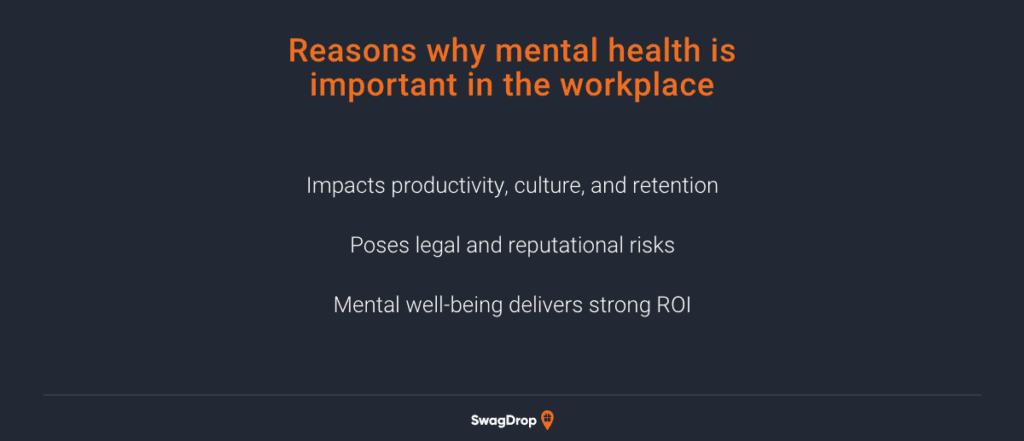
Let’s take them one by one.
Impacts productivity, culture, and retention
Poor mental health can significantly affect workplace productivity.
The 2024 Harris Poll survey revealed that 35% of US full-time employees report that stress related to their mental health impacts their job performance.
This stress can also cause increased absenteeism and higher turnover rates. Moreover, employees experiencing mental health challenges can negatively impact team morale and collaboration, creating a ripple effect throughout the organization.
Conversely, if you create a supportive work environment that prioritizes mental well-being, you can improve concentration and creativity while also building loyalty among staff members.
You can achieve this goal by implementing regular mental health check-ins, conducting employee wellness surveys, and promoting a company culture of psychological safety.
Poses legal and reputational risks
Neglecting mental health in the workplace can expose you to legal liabilities and damage your company’s reputation.
In the US, several laws require employers to recognize and address mental health concerns in the workplace, including:
- The Americans with Disabilities Act (ADA) protects employees with mental health conditions by requiring companies to provide reasonable accommodations, such as flexible schedules or modified workloads.
- The Family and Medical Leave Act (FMLA) allows eligible employees to take unpaid leave for severe mental health conditions without fear of losing their jobs.
Failing to comply with these laws can lead to costly lawsuits, increased HR conflicts, and reputational harm.
Moreover, inaction can be interpreted as negligence, particularly if an employee reports mental health struggles and receives no support.
On top of all that, the viral backlash of poor employee mental health treatment can damage your brand and recruitment efforts.
Mitigate these risks by developing a clear mental health policy, offering training for managers on legal obligations, and creating accessible ways for employees to request support or accommodations.
Mental well-being delivers strong ROI
Investing in mental health programs can yield substantial returns.
In fact, an in-depth Deloitte analysis found that for every dollar invested in workplace mental health, employers can expect a $4.10 return.
These impressive ROI results are from reduced absenteeism, lower staff turnover, and enhanced productivity.
Simple measures like flexible work arrangements and mental health days can significantly improve employee retention and engagement.
Unfortunately, work affects your team’s mental health in more ways than one, as you’ll see next.
How Does Work Impact Mental Health?
The work environment can be a source of connection, purpose, and growth, and a driver of stress, burnout, and emotional strain.
Therefore, if you want your employees to thrive, you need to understand how different elements of work impact their mental wellness and adjust accordingly.
Unmanageable workloads lead to chronic stress and burnout
When deadlines pile up, tasks keep growing, and breaks feel impossible, employees begin to unravel.
This pressure causes exhaustion, diminished concentration, irritability, and burnout.
According to the 2024 NAMI Workplace Mental Health Poll, 52% of employees reported feeling burned out because of their job, while 37% felt so overwhelmed that it affected their ability to function.
Support employees by scheduling regular check-ins, rebalancing assignments, and clearly outlining what takes priority.
Poor management practices create anxiety and disengagement
A skilled manager can boost morale, while a poor one can become a major source of stress.
Micromanagement, vague expectations, or unresponsiveness can make employees feel anxious and unsupported.
This kind of work environment increases turnover rates and reduces trust.
Address this problem by offering leadership training focusing on empathy, communication, and emotional intelligence.
Providing regular feedback and setting clear, realistic goals can also help team members feel secure and motivated.
A toxic or isolating culture increases the risk of depression
Toxic workplace cultures are often characterized by gossip, exclusion, or fear of speaking out.
These environments diminish psychological safety and make employees feel isolated.
Moreover, when people feel like they don’t belong, their symptoms of anxiety or depression can increase.
Build a workplace culture of connection and trust through inclusive team-building activities, DEI workshops, and open forums for honest conversation.
Lack of recognition affects motivation and self-worth
Everyone wants to feel seen and valued.
In fact, 81.9% of employees agree that being recognized for their contributions improves their engagement, according to a 2023 Nectar survey.
Alternatively, if hard work goes unnoticed, motivation drops, and self-doubt creeps in.
Small, frequent gestures, like giving shoutouts in company meetings or offering budget-friendly gifts with handwritten thank you notes, can go a long way.
However, if you want to boost overall team morale and make everyone feel cherished, we recommend throwing an awesome employee appreciation party once a year.
Next, we’ll explain the four pillars of a positive mental health work environment.
What Are the 4 As of a Mental Health-Friendly Workplace?
The 4 As of a mental health-friendly workplace offer an easy-to-remember framework for building a supportive environment.
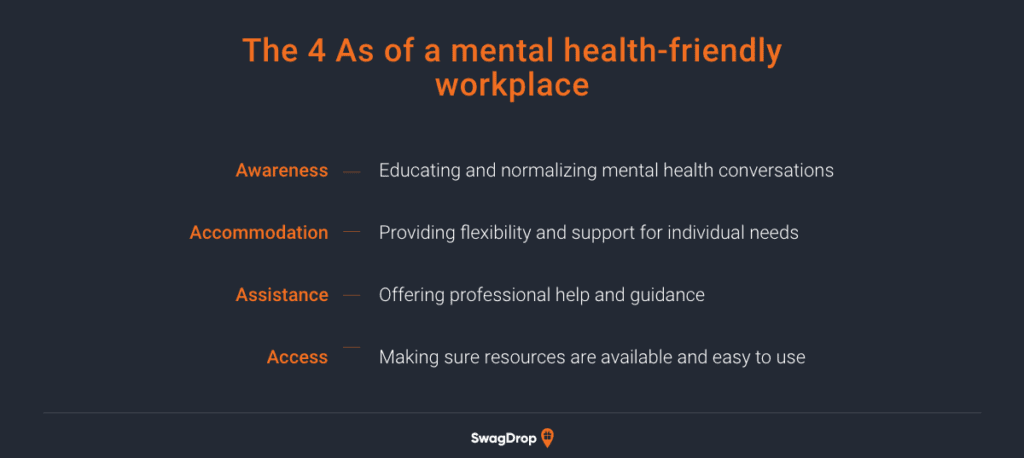
Awareness
Awareness means educating your staff about mental health issues and creating a safe space for open dialogue through workshops, awareness campaigns, and World Mental Health Day events.
You can host speaker sessions, share personal stories internally, or run interactive activities that reduce stigma.
Alternatively, you can start small by sending monthly mental health tips or sharing curated content on your team’s Slack channel.
Accommodation
Accommodation involves flexible hours, remote work options, and designated quiet spaces for breaks or decompression.
Some companies also offer mental health days that don’t require justification.
Ask employees what they need and respond with empathy and flexibility.
For instance, you can reduce sensory overload for someone with ADHD or reduce the number of in-person business meetings for an employee with anxiety.
Assistance
Assistance connects employees with mental health resources and support systems, like EAPs, confidential counseling, and paid mental wellness apps.
Lead by example and talk about how you go to therapy or use different wellness benefits to help others feel comfortable doing the same.
Promote these resources regularly so employees perceive them as a strength, not a last resort.
Access
Access entails ensuring that mental health resources aren’t hidden or challenging to find.
Employees need quick, clear ways to get help.
For example, you can create a digital wellness hub or provide printed wallet cards with hotline numbers or QR codes linking to self-care tools.
Make access effortless, and your employees will be more likely to use the support you’ve invested in.
Understanding the 4 As is a good start, but knowing why mental health initiatives sometimes fail can help you avoid common missteps.
Let’s explore that next.
Why Do Workplace Mental Health Initiatives Fail (And How Can You Avoid It)?
Many companies want to support employee mental health, but not every initiative hits the mark.
Here’s why some mental health programs fall flat and how to build successful ones.
One-off events without follow-up lose momentum
A single seminar or newsletter can raise awareness, but won’t create lasting change.
Mental health needs ongoing attention, and the initial excitement fades away without follow-ups.
Build a calendar of recurring activities like monthly check-ins, seasonal wellness campaigns, or mental health spotlights.
Keep the conversation going all year round, not just during Mental Health Month.
Lack of leadership involvement sends mixed messages
Employees watch what leaders do. Therefore, if company leaders don’t engage in mental health efforts, this sends the message that those initiatives aren’t a real priority.
Encourage your managers and team leaders to take mental health days, show up at workshops, and speak openly about stress or burnout to help reduce stigma.
You can assign a representative for every wellness program to increase visibility and engagement.
Employees don’t feel safe to engage
Even if you offer extensive resources, employees can still hold back if they fear judgment or backlash.
Gradually build psychological safety by providing anonymous ways to share feedback, such as surveys or suggestion boxes.
Most importantly, normalize vulnerability by sharing your own mental health challenges, encouraging others to do the same.
Programs aren’t tailored to real employee needs
A one-size-fits-all approach won’t resonate with a diverse workforce.
Use surveys, focus groups, or employee committees to learn what your staff needs and design effective programs based on these insights.
To increase engagement, provide various tools tailored to different mental health issues, employee roles, or work styles.
Now, let’s wrap this up!
Tips, tricks, and inspiration delivered straight to your inbox.
Over to You!
Supporting mental well-being at work starts with small, meaningful actions.
Each mental health awareness activity on this list, from mindfulness breaks to wellness gifts, helps create a workplace culture of care, connection, and resilience.
Employees who feel seen and supported give their best at work and beyond.
Generate buzz around your mental health programs with thoughtful, customizable swag items that promote overall well-being.
Browse our SwagDrop shop for more inspiring gift ideas your team will love.




